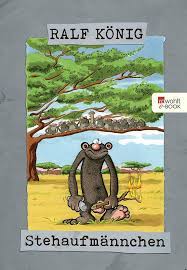blauschrift finished reading Stehaufmännchen by Ralf König

Stehaufmännchen by Ralf König
Afrika vor sechs Millionen Jahren. Grüner Urwald weicht der Savanne, und die Affen beschließen: „Runter vom Baum!“ Aber mit dem …
So happy to be here now - having quit GR years ago and then not tracking books at all. Will always post in German and English (but mainly on German books).
💙 Love "social reading". Have a queer-feminist-bookclub, going to (independant) book stores with a friend and enjoy live author readings. 💙 Into contemporary + classic novels, non-ficion, graphic novels. queer-feminist and critical approaches.
Blog: www.blauschrift.de/ List of blue books: bookwyrm.social/list/3694/s/blue-books Mastodon: literatur.social/@blauschrift Vernissage: vernissage.pnpde.social/@blauschrift
🐦 Profile pic: Is one of my 5 budgies / parrots.
This link opens in a pop-up window
64% complete! blauschrift has read 16 of 25 books.

Afrika vor sechs Millionen Jahren. Grüner Urwald weicht der Savanne, und die Affen beschließen: „Runter vom Baum!“ Aber mit dem …

Harter Psüchater in voller Pracht: Die Luxusausgabe limitiert auf 969 Exemplare!
Nach "Vervirte Zeiten" und "ABBA Hallo!" legt Ralf …

Seit seiner Gründung im Jahre 1981 hat sich der Chaos Computer Club stets in politisch-technische Debatten eingemischt. In diesen mehr …

September 1913, Görbersdorf in Niederschlesien. Inmitten von Bergen steht seit einem halben Jahrhundert das erste Sanatorium für Lungenkrankheiten. Mieczysław Wojnicz, …
@JonasJRichter@buecher.pnpde.social War neugierig. Weil du es zwei mal oder so erwähnt hast, dass es von da kam, da hing es regelrecht in der Luft 😊. Finde immer spannend, welchen Weg Bücher gehen.
@JonasJRichter@buecher.pnpde.social ... und stellst du es wieder dorthin zurück? 🤔

September 1913, Görbersdorf in Niederschlesien. Inmitten von Bergen steht seit einem halben Jahrhundert das erste Sanatorium für Lungenkrankheiten. Mieczysław Wojnicz, …
@drkprmbs Oooh hätte gedacht, Olga Tokarczuk kann gar nicht enttäuschen. Dient all die quirkiness denn einem Zweck? Wird damit was vorgeführt? (Und Meta: Da steht der Name der Hörbuchsprecherin statt der Autorin in der Buchlistung. Bin gerade am Handy, da ist es unpraktisch zu korrigieren)

Mit Wärme, Wucht und Witz erzählt Paula Fürstenberg in »Weltalltage« von einer besonderen Freundschaft und deren Zerreißprobe. Davon, was es …
@BlueBooks@buecher.pnpde.social Falls du auch mal Hörbücher magst, kann ich dir die deutsche Version empfehlen. Die ist absolut köstlich gelesen und setzt manche Figuren mehr in den Kontext von Agathas griesgrämiger 'Brille'.
Aber gut, dass du Ablenkung gefunden hast.
@BlueBooks@buecher.pnpde.social Falls du auch mal Hörbücher magst, kann ich dir die deutsche Version empfehlen. Die ist absolut köstlich gelesen und setzt manche Figuren mehr in den Kontext von Agathas griesgrämiger 'Brille'.
Aber gut, dass du Ablenkung gefunden hast.

Zwei Welten prallen aufeinander: das kleinbürgerliche Grillfest auf der Terrasse einer Doppelhaushälfte in Schweinfurt und das unkonventionelle Liebesfest auf der …

Zwei Welten prallen aufeinander: das kleinbürgerliche Grillfest auf der Terrasse einer Doppelhaushälfte in Schweinfurt und das unkonventionelle Liebesfest auf der …

Das Känguru und Marc-Uwe kommentieren den alltäglichen Wahnsinn – und zwar als Comicfiguren! Sie diskutieren die wirklich wichtigen Fragen des …